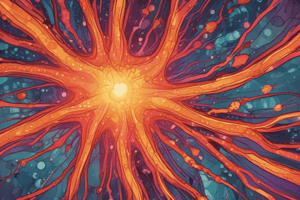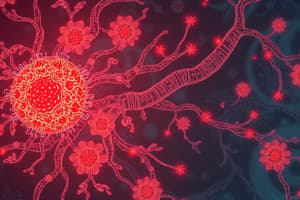Podcast
Questions and Answers
Which of the following is NOT a cause of inflammation?
Which of the following is NOT a cause of inflammation?
- Cigarette smoke
- Pathogens
- Injury
- Physical exercise (correct)
Normal inflammation always leads to severe complications.
Normal inflammation always leads to severe complications.
False (B)
Name an autoimmune disease that can cause significant inflammation.
Name an autoimmune disease that can cause significant inflammation.
Rheumatoid arthritis
Inflammation can be caused by _________, damaged cells, and irritants.
Inflammation can be caused by _________, damaged cells, and irritants.
Match the following conditions with their descriptions:
Match the following conditions with their descriptions:
Which of the following is NOT one of the five manifestations of inflammation?
Which of the following is NOT one of the five manifestations of inflammation?
Inflammation is a specific immune response to invasion or damage.
Inflammation is a specific immune response to invasion or damage.
What is the primary purpose of inflammation in the healing process?
What is the primary purpose of inflammation in the healing process?
Disorders characterized by inflammation typically end with the suffix __________.
Disorders characterized by inflammation typically end with the suffix __________.
Match the following agents with their types related to inflammation:
Match the following agents with their types related to inflammation:
What is the primary purpose of inflammation?
What is the primary purpose of inflammation?
Chronic inflammation always follows acute inflammation.
Chronic inflammation always follows acute inflammation.
Name one chemical mediator released by mast cells during the inflammatory response.
Name one chemical mediator released by mast cells during the inflammatory response.
The five typical signs of inflammation are erythema, heat, swelling, pain, and ________.
The five typical signs of inflammation are erythema, heat, swelling, pain, and ________.
Match the type of inflammation with its description:
Match the type of inflammation with its description:
What is the term for the increase in blood supply to an injured area during inflammation?
What is the term for the increase in blood supply to an injured area during inflammation?
Leukocytosis refers to a decrease in the number of white blood cells in the bloodstream.
Leukocytosis refers to a decrease in the number of white blood cells in the bloodstream.
What causes pain during the inflammatory process?
What causes pain during the inflammatory process?
In inflammation, leukocytes first _____ along the vessel wall before adhering to it.
In inflammation, leukocytes first _____ along the vessel wall before adhering to it.
Match the following terms related to inflammatory response:
Match the following terms related to inflammatory response:
What effect does increasing vascular permeability during inflammation have?
What effect does increasing vascular permeability during inflammation have?
The reparative phase is the last stage of inflammation.
The reparative phase is the last stage of inflammation.
What is the process by which the body produces more leukocytes during inflammation?
What is the process by which the body produces more leukocytes during inflammation?
What is the primary component of purulent exudate?
What is the primary component of purulent exudate?
Hemorrhagic exudate is typically clear and watery.
Hemorrhagic exudate is typically clear and watery.
What is the term for the liquid that leaks out of blood vessels during inflammation?
What is the term for the liquid that leaks out of blood vessels during inflammation?
Serous exudate is usually associated with a __________ inflammatory process.
Serous exudate is usually associated with a __________ inflammatory process.
Match the types of exudate with their descriptions:
Match the types of exudate with their descriptions:
What contributes to the composition of inflammatory exudate?
What contributes to the composition of inflammatory exudate?
Which factors determine the amount and composition of exudate produced during inflammation?
Which factors determine the amount and composition of exudate produced during inflammation?
What role do cytokines play in the production of exudate during inflammation?
What role do cytokines play in the production of exudate during inflammation?
Which statement is correct regarding the term 'exudate'?
Which statement is correct regarding the term 'exudate'?
What is primarily indicated by an increase in the amount of exudate during inflammation?
What is primarily indicated by an increase in the amount of exudate during inflammation?
Which type of tissue has the least ability to regenerate after damage?
Which type of tissue has the least ability to regenerate after damage?
Scar tissue functions the same as the original tissue it replaces.
Scar tissue functions the same as the original tissue it replaces.
What is the term for the fragile, gelatinous tissue formed during the early stages of tissue repair?
What is the term for the fragile, gelatinous tissue formed during the early stages of tissue repair?
Fibrous tissue that forms when regeneration is not possible is known as ____________.
Fibrous tissue that forms when regeneration is not possible is known as ____________.
Match the following stages of tissue repair with their descriptions:
Match the following stages of tissue repair with their descriptions:
Flashcards are hidden until you start studying
Study Notes
Inflammation Response
-
Inflammation is a non-specific response to harmful stimuli aimed at reducing damage
-
Inflammation can be caused by various agents, including injuries, infections, autoimmune diseases, pathogens, damaged cells, and irritants like cigarette smoke.
-
Inflammation is a protective process that typically stimulates healing and prevents further damage
-
Occasional discomfort from inflammation often resolves with palliative care
Complications of Inflammation
-
Inflammation can escalate and lead to complications like autoimmune disorders.
-
Examples of autoimmune disorders linked to inflammation include rheumatoid arthritis (RA), psoriasis, systemic lupus erythematosus (SLE), and Guillain-Barré syndrome.
-
Autoimmune disorders may require more aggressive care, including pharmacotherapy.
Inflammation
- Inflammation is a body's natural response to injury or illness
- Inflammation is the first step in the healing process
- Inflammation brings fluid, dissolved substances, and blood cells to the injured area.
- This response is non-specific, meaning the same events occur regardless of the cause of the inflammation.
- Inflammation is designed to neutralize and eliminate invaders, remove damaged tissue, and start healing and repair.
- Inflammation can be caused by: microorganisms, chemical agents, and physical agents
- Microorganisms that cause inflammation include: bacteria, viruses, fungi, helminths, and protozoans
- Chemical agents that cause inflammation include: internal substances like hydrochloric acid and external substances like poisons
- Physical agents that cause inflammation include: trauma to the skin, excessive heat or cold, and radiation.
- Disorders involving inflammation usually end in "-itis". Examples include: bronchitis, colitis, and gastritis.
- There are five common signs of inflammation:
- Erythema (redness)
- Heat
- Swelling
- Pain
- Impaired function (potential)
Inflammation
- The inflammatory process protects the body by isolating damaged areas and promoting repair.
- Inflammation can be acute or chronic.
- Acute inflammation occurs within minutes to hours after an injury, infection, or other harmful stimulus.
- Five key signs of acute inflammation are redness, heat, swelling, pain, and impaired function.
- Acute inflammation resolves when the harmful stimulus is neutralized.
- Mast cells release chemical mediators (histamine, bradykinin, complement, and leukotrienes) during acute inflammation.
- These mediators cause:
- Vasodilation (redness and heat)
- Vascular permeability (edema)
- Cellular infiltration (pus)
- Thrombosis (clots)
- Stimulation of nerve endings (pain)
- Chronic inflammation can occur when acute inflammation fails to neutralize the harmful stimulus.
- Chronic inflammation can persist for months or years.
- Chronic inflammation can be caused by various factors such as seasonal allergies, autoimmune diseases, and persistent infections.
- Chronic inflammation does not usually follow acute inflammation.
- Examples of chronic inflammatory diseases include chronic obstructive pulmonary disease (COPD) and systemic lupus erythematosus (SLE).
Inflammation Stages
-
Inflammation has three stages: vascular and cellular responses, exudate production, and reparative phase.
-
Vascular and Cellular Responses:
- Blood Vessels: After injury or infection, blood vessels constrict briefly before dilating due to chemical mediators like histamine, kinins, and prostaglandins.
- Hyperemia: Increased blood flow causes redness (erythema) and heat.
- Vascular Permeability: Increased permeability leads to fluid, proteins, and white blood cells (WBCs) leaking into tissues, causing swelling (edema) and pain.
- Pain: Edema compresses nerve endings, and inflammatory mediators irritate them.
- Fluid Accumulation: Pulmonary edema can occur if fluid accumulates in the lungs, affecting oxygenation and carbon dioxide excretion. Joint mobility may be impaired if fluid accumulates around joints.
- Leukocyte Margination: Slowed blood flow allows WBCs to adhere to the vessel wall, a process called margination.
- Leukocyte Transmigration: WBCs move across the vessel wall to the injury site.
- Leukocytosis: Bone marrow produces more WBCs and releases them into the blood, increasing the WBC count.
-
Exudate Production:
- Exudate: Fluid with high protein and WBC content that leaks into the injured area.
- Types of Exudate:
- Serous exudate: Clear, watery fluid containing little protein.
- Purulent exudate: Thick, yellow-white fluid containing pus (dead WBCs, bacteria, and debris).
- Fibrinous exudate: Thick, sticky fluid containing fibrin, which can lead to scarring.
- Hemorrhagic exudate: Exudate containing blood, indicating significant vascular damage.
-
Reparative Phase:
- Begins shortly after the injury and continues for days, weeks, or even months depending on the severity of the injury.
- Tissue Repair: The body attempts to restore the injured tissue to its original state.
- Scar Formation: If the injury is severe, scar tissue may form.
- Regeneration: Some tissues, such as skin and liver, are able to regenerate and return to their original state.
Inflammatory Exudate
- Exudate is a fluid that leaks out of blood vessels.
- Exudate is produced during the second stage of inflammation.
- Exudate contains fluid from blood vessels, cytokines, histamines, dead tissue cells, injured tissue cells, and dead phagocytic cells.
- The amount and content of exudate is determined by the tissue involved, the amount of damage, the duration of inflammation, and the intensity of the initial inflammatory process.
### Types of Exudate
- Serous exudate: clear or straw-colored, watery consistency, associated with mild inflammatory processes.
- Purulent exudate: Milky or opaque, contains leukocytes, other cells, and necrotic debris, indicates an infection.
- Hemorrhagic exudate: Red and thick, contains blood from ruptured vessels, found in injuries to capillaries due to direct damage or pressure from edema.
Inflammatory Exudate
- Exudate is a fluid that leaks out of blood vessels during the second stage of inflammation.
- The word "exudate" comes from Latin, meaning "to exude" or "to ooze."
- Exudate contains:
- Fluid from blood vessels
- Cytokines
- Histamines
- Dead tissue cells
- Injured tissue cells
- Dead phagocytic cells
- The amount and composition of exudate vary depending on factors such as:
- The specific tissue involved
- The extent of tissue damage
- The duration of inflammation
- The intensity of the initial inflammatory process
Reparative Phase
- The reparative phase is the final stage of the inflammatory response, where the body shifts focus from inflammation to repair.
- Chemical mediators facilitate the repair of damaged cells.
- Regeneration replaces destroyed cells with identical or similar cells, restoring tissue structure and function.
- Tissues like skin, digestive and respiratory tracts, bone, and bone marrow regenerate quickly, especially if their underlying support structures are intact.
- Tissues with limited regenerative capacity include nervous, muscular, and elastic tissues.
- Scar tissue formation occurs when regeneration is not possible.
- Fibrin assists in tissue repair by creating a network that supports the healing process.
- In the early stages of repair, granulation tissue forms, a delicate, gelatinous tissue rich in capillaries.
- As the repair progresses, granulation tissue contracts, reducing capillaries and collagen fibers, leading to the formation of scar tissue.
- Scar tissue, while essential for repair, lacks the original tissue's function and can cause complications, such as restricted heart function after a heart attack.
Studying That Suits You
Use AI to generate personalized quizzes and flashcards to suit your learning preferences.




